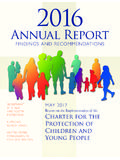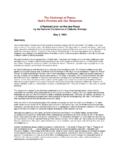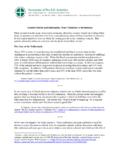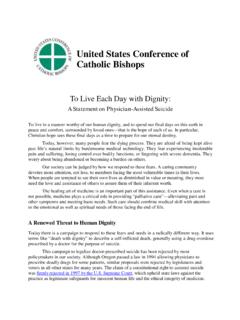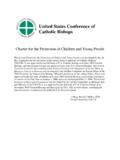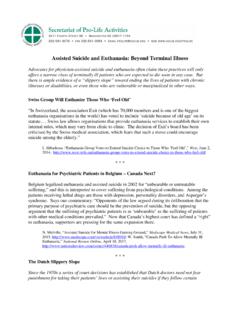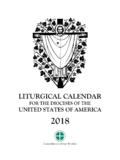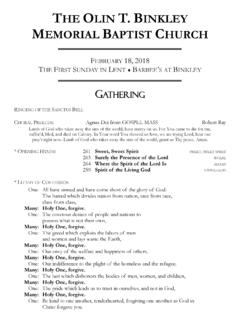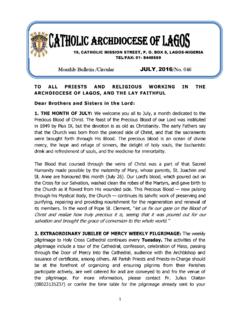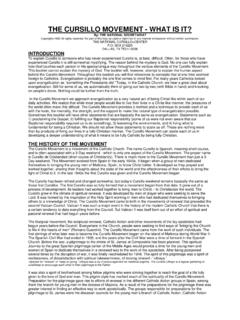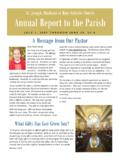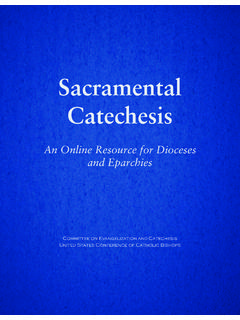Transcription of Ecclesial Movements as Agents of a New Evangelization
1 Ecclesial Movements as Agents of a New Evangelization by H. Richard McCord A new Evangelization is synonymous with mission, requiring the capacity to set out anew, go beyond boundaries and broaden horizons. The new Evangelization is the opposite of self-sufficiency, a withdrawal into oneself, a status quo mentality and an idea that pastoral programs are simply to proceed as they did in the past. (Synod of Bishops, XIII Ordinary General Assembly, The New Evangelization for the Transmission of the Christian Faith, Lineamenta, no. 10) In recent years the Holy Father and the bishops have called the Catholic faithful to undertake a New Evangelization .
2 This call has been given special prominence by the Holy Father s decision to convene the next international Synod of Bishops on The New Evangelization for the Transmission of the Christian Faith. The preparatory document (Lineamenta) for this synod reminds us that the newness of the New Evangelization is more than rhetorical flourish. It has significance and consequences. It must be, in the words of Blessed John Paul II, new in ardor, methods and expression (apostolic exhortation On the Encounter with the Living Jesus Christ: The Way to Conversion, communion , and Solidarity in America [Ecclesia in America], no.)
3 6, ). This essay examines one such example of a new approach to Evangelization , namely, the phenomenon of Ecclesial Movements . Ecclesial Movements is a collective term for many volunteer groups and associations that have arisen within the church , mostly in the twentieth century. They offer the possibility of going beyond boundaries to broaden the horizons of mission and ministry. This essay will describe the Movements in general terms, provide some historical perspective on their emergence, and then reflect on their potential role in the New Evangelization and transmission of faith in a changing social milieu and a culturally diverse Ecclesial environment.
4 movement is a contemporary term applied to Ecclesial groups and associations of the Christian faithful and used to accentuate their newness, dynamism, spontaneity, and a certain charismatic quality in how they were founded and in how they carry out their 2 work. To say that something is a movement calls attention to the initiative of the Holy Spirit who distributes gifts and graces by which all the faithful can contribute to the building up of the church (see Second Vatican Council, Dogmatic Constitution on the church [Lumen Gentium], no. 12, in Vatican Council II: Volume 1: The Conciliar and Post Conciliar Documents, ed.)
5 Austin Flannery [Northport, NY: Costello Publishing, 1996]). Some examples of contemporary Ecclesial Movements that exist to a greater or lesser extent in the United States are Catholic Charismatic Renewal, Cursillo, Christian Life Communities, Christian Family movement , Movimiento Familiar Cristiano, Focolare, Neocatechumenal Way, Marriage Encounter, communion and Liberation, and L Arche. These diverse groups have certain common characteristics that could constitute a summary description of an Ecclesial movement . With some exceptions, all Movements have A founder whose particular charism gave birth to the movement Predominantly, but not exclusively, lay membership Some Ecclesial structure and communal expression A set of teachings and methods that flesh out the movement s charism An explicit commitment to an evangelizing mission A relationship with ecclesiastical authorities Ecclesial Movements are examples of the necessarily diverse forms of participation in the life of the church something that the Second Vatican Council commended as the group form of the apostolate (Paul VI.
6 On the Apostolate of Lay People [Apostolicam Actuositatem], nos. 18-20, in Vatican Council II: Volume 1). Ecclesial Movements follow in a long tradition of groups, associations, and communities that have arisen throughout the history of the church . To meet specific needs of the time and to pursue mission-oriented purposes, the Holy Spirit has raised up from the lay faithful various monastic and mendicant orders, confraternities, sodalities, charitable and educational societies, social welfare organizations, and Catholic Action groups. In the modern period, and due largely to the encouragement of the Second Vatican Council, the Ecclesial Movements represent a new era of group endeavors of the lay faithful (John Paul II, apostolic exhortation On the Vocation and the Mission of the Lay Faithful in the church and in the World [Christifideles Laici], no.
7 29, ). Many of the Movements that operate in the United States today were established first in Europe or Latin America. Over the course of time, particularly through the influence of immigration, they have made their way to this country. Sometimes the social conditions in another country that facilitated the emergence of a given movement are not replicated in our own nation. Consequently, some Movements have had difficulty being understood and accepted here. The existence of a strong system of parishes in the United States a situation that is not the case in other countries has also modified, or perhaps impeded, the growth of Ecclesial Movements .
8 3 Within the unity of the church s communion and mission, all the faithful have, by reason of their Baptism, both the freedom and the right to form associations (see Apostolicam Actuositatem, no. 19; Paul VI, On the Ministry and Life of Priests [Presbyterorum Ordinis], no. 8, in Vatican Council II: Volume 1; and Code of Canon Law: Latin-English Edition: New English Translation [Codex Iuris Canonici (CIC)] [Washington, DC: Canon Law Society of America, 1998], c. 215). This is exercised within a broader understanding of the church as an organic communion of vocations, ministries, services, charisms, and responsibilities.
9 No specific authorization by the hierarchy is needed to form or join an association, although the hierarchy can give it recognition and even grant it juridical status (see CIC, cc. 298-301). An association or movement cannot use the name Catholic without consent from competent ecclesiastical authority (see CIC, c. 300). Ecclesial Movements enjoy a measure of flexibility, fluidity, and the ability to appeal to people who want to engage in a particular apostolic activity, use a certain style of prayer, or follow a set of spiritual practices. Movements can function in a much more homogeneous and focused manner than parishes.
10 Recent trends show that parishes are growing larger as mergers and consolidations take place and as the Catholic population increases. As a result, parishioners can feel lost and nameless. By contrast, Movements can be more relational and communal. They can give members more opportunities to connect with others, share their gifts, and receive support for living a Christian life. John Paul II even raised the possibility that some large parishes might become a community of communities and Movements in order to renew themselves (Ecclesia in America, no. 41). Because Movements tend to be keenly aware of their mission, more intentional about their methods and audiences, and possibly more willing and able to innovate, they seem well positioned to be leaders in the New Evangelization .

